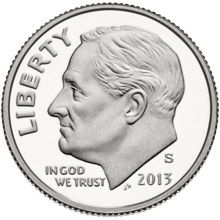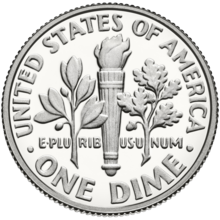Dime (U.S. coin)
| United States | |
| Value | 0.10 U.S. dollar |
|---|---|
| Mass | 2.268 g (0.0729 troy oz) |
| Diameter | 17.91 mm (0.705 in) |
| Thickness | 1.35 mm (0.053 in) |
| Edge | 118 reeds |
| Composition | 91.67% Cu 8.33% Ni |
| Years of minting | 1796–present |
| Catalog number | – |
| Obverse | |
 |
|
| Design | Franklin D. Roosevelt |
| Designer | John R. Sinnock |
| Design date | 1946 |
| Reverse | |
 |
|
| Design | Olive branch, torch, oak branch |
| Designer | John R. Sinnock |
| Design date | 1946 |
The dime, in U.S. usage, is a ten-cent coin, one tenth of a United States dollar, labeled formally as "one dime". The denomination was first authorized by the Coinage Act of 1792. The dime is the smallest in diameter and is the thinnest of all U.S. coins currently minted for circulation, being .705 inches (17.91 mm) in diameter and .053 inches (1.35 mm) in thickness. The obverse of the coin depicts the profile of President Franklin D. Roosevelt and the reverse boasts an olive branch, a torch, and an oak branch, from left to right respectively. As of 2011, the dime coin cost 5.65 cents to produce.
The word "dime" comes from the French word "dîme", meaning "tithe" or "tenth part", from the Latin decima [pars]. In the past prices have occasionally been quoted on signage and other materials in terms of dimes, abbreviated as "d" or a lowercase "d" with a slash through it (₫) as with the cent and mill signs.
The Coinage Act of 1792 established the dime (spelled "disme" in the legislation), cent, and mill as subdivisions of the dollar equal to 1⁄10, 1⁄100 and 1⁄1000 dollar respectively.
The first known proposal for a decimal-based coinage system in the United States was made in 1783 by Thomas Jefferson, Benjamin Franklin, Alexander Hamilton, and David Rittenhouse. Hamilton, the nation's first Secretary of the Treasury, recommended the issuance of six such coins in 1791, in a report to Congress. Among the six was a silver coin, "which shall be, in weight and value, one tenth part of a silver unit or dollar".
...
Wikipedia
